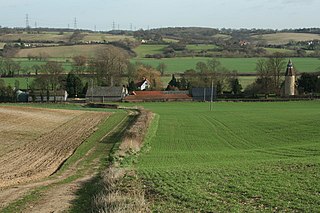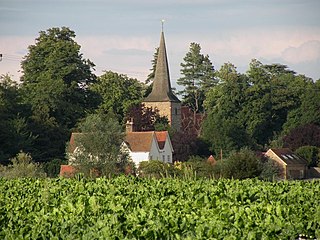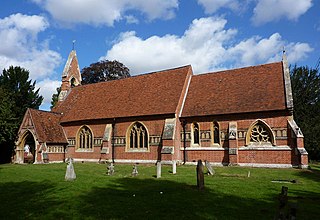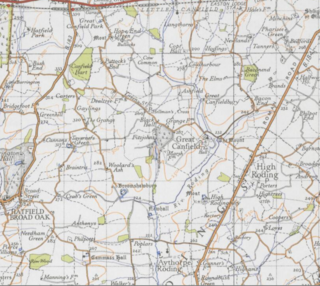
Alice Perrers, also known as Alice de Windsor was an English royal mistress, lover of Edward III, King of England. As a result of his patronage, she became the wealthiest and most influential woman in the country. She was widely despised and accused of taking advantage of the old king.

Walsingham is a civil parish in North Norfolk, England, famous for its religious shrines in honour of Mary, mother of Jesus. It also contains the ruins of two medieval monastic houses. Walsingham is 27 miles (43 km) northwest of Norwich.

Acton Turville is a parish in the Cotswold Edge ward within South Gloucestershire, England. It lies 17 miles (27 km) east-northeast of Bristol and 93 miles (150 km) due west of London, with the M4 south of the parish. Acton Turville consists of a cluster of households across 1,009 acres, with a total population of 370 people. Acton Turville is also listed as "Achetone" in the Domesday Book.

Hill is a village and civil parish in South Gloucestershire, England, midway between the towns of Thornbury in South Gloucestershire and Berkeley in Gloucestershire. The parish stretches from the banks of the River Severn to an outcrop of the Cotswolds escarpment. At the 2001 census, it had a population of 114. Hill is approximately 5 miles from the M5 motorway which links to Gloucester, Cheltenham and Bristol.

Pitchford is a small village in the English county of Shropshire. It is located between Cantlop and Acton Burnell and stands on an affluent of the River Severn. Pitchford takes its name from a bituminous spring/pitch in the village, located near The Row Brook.

Clayworth is a village and civil parish in Nottinghamshire, England. At the time of the 2001 census it had a population of 319, increasing to 419 at the 2011 Census. The village is located 6 miles (9.7 km) north-east of Retford, on the River Idle. Clayworth appears as Clavord in the Doomsday Book, where 37 households were registered in the parish, which in the context of the Doomsday Book was considered to be a large population. At that time Clayworth paid low amounts of tax at 2 geld units. By 1769 Clayworth appears as Cloworth. Clayworth was described in John Bartholomew's Gazetteer of the British Isles of 1887 as having a population of 439, with 2,076 acres of land.

Whitgreave is a very small village a few miles to the NNW of Stafford situated midway between the M6 motorway to the west and the A34 trunk road to the east.

Chetton is a small village and civil parish in Shropshire, England. According to the 2011 census the parish had a population of 349. It is about 20 miles (32 km) to the West of Wolverhampton in West Midlands and South of Telford. The parish church has a fine set of church bells.

Flowton is a village and civil parish in the Mid Suffolk district of Suffolk in eastern England, with a population of 117 people. The name 'Flowton' originally derives from the word 'Flocctun', meaning a flock of sheep or a sheep farm. The parish is located around six miles north west of Ipswich, which is the county town of Suffolk. Flowton contains the hamlet of Flowton Brook, and consists of rural farmland accompanied by scattered farm houses and a few newer builds situated nearby the parish church of 'St Mary's'. In the 1870s, Flowton was described as:

Withersfield is a village and civil parish in the West Suffolk district of Suffolk in eastern England. In 2011 its population was 450. It has a public house and a village hall, and centres on the parish church, St. Mary the Virgin. It is in a rural location, surrounded by farmland, yet only a mile north of the busy market town of Haverhill. Surrounding villages include Great Wratting, West Wickham and Great Thurlow.

Stansfield is a village and civil parish in the West Suffolk district of Suffolk in eastern England. Located seven miles south-west of Bury St Edmunds, in 2011 its population was 221. The village has an Anglican church dedicated to All Saints. In 1870, John Marius Wilson's Imperial Gazetteer of England and Wales described Stansfield as

Great Tey is a village and civil parish in the City of Colchester district of Essex, England. It is near the villages of Marks Tey and Little Tey, located approximately six miles west of Colchester.

Lamarsh is a village and a civil parish in the Braintree District, in the county of Essex, England. It is near the large village of Bures and the village of Alphamstone. The village is west of the River Stour. It has a pub, a village hall and a church called The Friends of Holy Innocents Church. The civil parish's name, Lamarsh, comes from the phrase "Loamy marsh". This is derived from the Old English terms lām and mersc, which translate into loam or clay and a marsh respectively.

Fairstead is a village and civil parish in the Braintree district of Essex, England. Whilst isolated in a community of farming hamlets, the parish of Fairstead has close connections with Great Leighs and is 9.8 miles (15.8 km) from Chelmsford, Essex's county town.

Eyke is a village and a civil parish in the East Suffolk district, in the English county of Suffolk. It is located on the A1152 road near the town of Woodbridge. Eyke has a primary school, the manor house of Lord and Lady Lucas with scenic pond and horse paddock, and a pub. The mediaeval parish church of All Saints was restored in the 1860s. Services are normally held on the first and third Sundays of the month.

Great Maplestead is a village and a civil parish in the Braintree District, in the English county of Essex.

Twinstead is a village and civil parish in the Braintree district in the county of Essex, England. It shares a parish council with Great Henny and Little Henny called "Hennys', Middleton & Twinstead". It was once part of the Hinckford Hundred, which is a subdivision of a county and has its own court. In 2001 the parish had a population of 165.

Great Canfield is a village and a civil parish in the Uttlesford district of Essex, England. The village, which sits at the south-east edge of its civil parish, is approximately 3 miles (5 km) south-west from the small town of Great Dunmow, and 1 mile (1.6 km) north-west from High Roding. The civil parish contains the hamlets and small settlements of Hope End Green, Hellmans Cross, Bacon End, Baconend Green, and Puttocks End. The River Roding defines the parish border at the south-east, and for 1 mile cuts through the parish before providing part of the north-east border.

Cookley is a small village and civil parish in the East Suffolk district, in the east of the county of Suffolk, England. Nearby settlements include the town of Halesworth and the village of Walpole. The village includes the church, cottages and a farm that follows the stream which joins the Blyth River at the town of Halesworth. The church and houses are on the rising ground to the North of the stream.

Little Henny is a hamlet and civil parish in the Braintree district in the county of Essex, England. It shares a parish council with Great Henny and Twinstead called "Hennys', Middleton & Twinstead". It is near the town of Sudbury in Suffolk. In 2001 the parish had a population of 48.


























